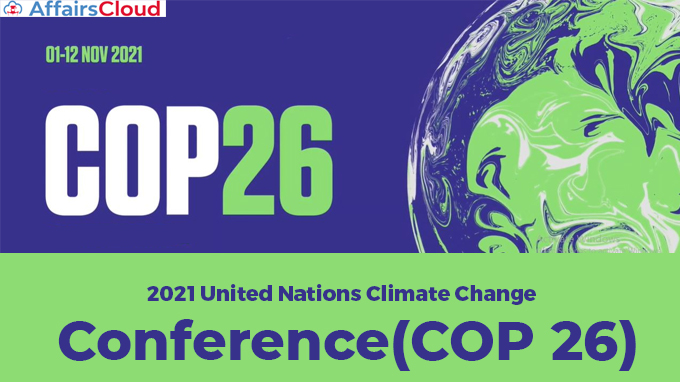 The 26th Conference of Parties (COP26) of the United Nations Framework Convention on Climate Change (UNFCCC) is being held in Glasgow, Scotland, United Kingdom (UK) from 31st October – 12 November 2021.
The 26th Conference of Parties (COP26) of the United Nations Framework Convention on Climate Change (UNFCCC) is being held in Glasgow, Scotland, United Kingdom (UK) from 31st October – 12 November 2021.
- Prime Minister (PM) Narendra Modi Visited the UK to attend the COP26 from November 1 to 2, 2021.
- The COP26 is being hosted by the United Kingdom, in partnership with Italy.
-India’s 5 Commitments set at COP 26
i.At the summit, the PM has set 5 ambitious targets for India to combat climate change. It includes that India will aim to attain net-zero emissions by 2070.
ii.The PM asserted that India is the only country that is delivering on the commitments on tackling climate change under the Paris Agreement.
| S.no | Commitments of India |
|---|---|
| 1 | To increase India’s non-fossil capacity to 500 gigawatt by 2030 |
| 2 | To fulfil 50 percent of India’s energy requirements with renewable energy by 2030 |
| 3 | To reduce 1 billion tonnes of the total projected carbon emission between 2020 and 2030 |
| 4 | To reduce the Indian economy’s carbon intensity to less than 45% by 2030 |
| 5 | To achieve the target of net zero emissions by 2070 |
iii.In order to support vulnerable island nations that are in the danger of submerging because of rising sea levels, the PM urged the rich countries to provide $ 1 trillion in climate finance to the developing world to achieve its climate change mitigation targets.
- The PM also urged to make ‘Lifestyle for Environment’ a global mission.
Note –
- As per the World Meteorological Organization (WMO), global sea level rose by 4.3mm per year – between 2013 and 2021, and the rate of rise is expected to jump further in the coming decade due to rising carbon emissions.
- India is the world’s 4th biggest emitter of carbon dioxide (CO2) after China, the US and the EU (European Union).
-India’s launch at COP26:
i.At the COP26, PM launched a programme IRIS (Infrastructure for the Resilient Island States), a key India-led initiative to boost infrastructure in small island nations.
- Small island states are the most vulnerable to climate change and they face the worst impacts.
ii.The new programme for the small island states is part of the Coalition for Disaster Resilient Infrastructure (CDRI), an Indian initiative announced by Modi at the UN General Assembly in 2019.
iii.So far, 25 other countries, including Germany, Italy, Japan, Australia, and the United States have joined the CDRI coalition.
iv.CDRI is the 2nd international collaboration set up by India in the climate change sphere, the other being the International Solar Alliance that has now evolved to the status of a treaty-based intergovernmental organisation.
v.India emitted 1.9 tonnes of CO2 per head of population in 2019, compared with 15.5 tonnes for the US and 12.5 tonnes for Russia.
-World’s 1st Green Grids Initiative Launched by Indian and UK
PM Modi and his British counterpart Boris Johnson jointly launched the world’s 1st ‘green Grids’ Initiative, the One Sun One World One Grid (GGI-OSOWOG) on the sidelines of the COP26 summit.
- Objective: To connect energy grids across borders to facilitate a faster transition to the use of renewable energy.
Key Points:
i.Under the initiative, the Indian Space Research Organisation (ISRO) has made available a solar calculator to inform countries about the solar potential of any place on the earth using satellite data.
- Note – The sun produces the amount of energy used by all humans in one year in just one hour.
ii.The International Solar Alliance (ISA), India Presidency of the ISA, and the UK COP Presidency, unveiled plans for the 1st international network of global interconnected solar power grids, GGI-OSOWOG, at the COP26 climate conference in Glasgow.
iii.The project was spearheaded by India and the UK in partnership with the ISA and the World Bank Group and aims to harness solar energy wherever the sun is shining.
iv.The declaration has been endorsed by 80 ISA member countries. The ISA’s recent analysis calls for a tripling in investment in grid expansion and modernisation from $260 billion to $800 billion annually by 2030.
v.ISA aims to mobilize US$1 trillion of funding by 2030 to assist developing countries in expanding their solar power grids to meet their energy needs.
vi.The global grid concept was 1st announced by the PM in October 2018 during the1st assembly of the ISA, in May 2021, the UK pledged technical, financial and research support for the OSOWOG project.
- ISA includes 90 signatories and 193 prospective members.
-India signs up to UK’s Breakthrough Agenda on affordable, cleantech
The UK government has launched a breakthrough Agenda, an international plan to deliver clean and affordable technology everywhere by 2030 at COP26.
- Among 40 leaders, PM Modi also has signed up the UK’s Breakthrough Agenda which was modelled on the UK’s landmark Net Zero Strategy. India joins the US, European Union, China, among others representing more than 70 percent of the world’s economy to sign up for the agenda.
- Under the Glasgow Breakthroughs, Boris Johnson has set out the 1st 5 goals, collectively covering more than 50 percent of global emissions.
5 Goals:
i.Power: Clean power is the most affordable and reliable option for all countries to meet their power needs efficiently by 2030.
ii.Road Transport: Zero-emission vehicles are the new normal and accessible, affordable, and sustainable in all regions by 2030.
iii.Steel: Near-zero emission steel is the preferred choice in global markets, with efficient use and near-zero emission steel production established and growing in every region by 2030.
iv.Hydrogen: Affordable renewable and low carbon hydrogen is globally available by 2030.
v.Agriculture: Climate-resilient, sustainable agriculture is the most attractive and widely adopted option for farmers everywhere by 2030.
-Countries pledge to cut methane, deforestation
After India’s five-point climate agenda, a Global methane pledge was launched to make a 30 percent reduction in global methane emissions from 2020 levels by 2030. The pledge is jointly led by the United States and the European Union. So far, over 90 countries have signed the pledge.
About Methane:
i.It is a dangerous greenhouse gas, with a global warming potential which is more than 80 times that of carbon dioxide, even though it remains in the atmosphere for significantly less time as compared to carbon dioxide.
ii.Methane accounts for about 17 percent of global greenhouse gas emissions and 25 percent of the warming that the world is experiencing.
iii.As per the Intergovernmental Panel on Climate Change report, methane accounts for about half of the 1.0 degrees Celsius net rise in global average temperature (since the pre-industrial era).
iv.Methane is the 2nd non-CO2 greenhouse gas that has been targeted for reduction. In 2016, the world had agreed to cut down the use of hydrofluorocarbons (HFCs) which are used extensively in the air-conditioning, refrigeration and furniture industries.
- HFCs are even more dangerous than methane in terms of their warming potential.
-Pledge to stop Deforestation
i.The pledge to stop and reverse deforestation by 2030 (not a formal agreement) was also made in the same manner. Over 100 countries including the U.S., China and Brazil have signed on to it.
ii.The agreement includes countries accounting for 85 percent of the world’s forest land. They have committed around $20 billion of public and private funds to protect and restore forests.
iii.The agreement is also a step forward from a similar pledge to save global forests made in 2014 at a summit in New York.
Note – In 2020, the world lost 258,000 sq km (100,000 sq miles) of the forest, an area larger than the United Kingdom, according to WRI’s (World Resources Institute) Global Forest Watch.
iv.India has not signed up to both the two pledges. China and Russia also have not signed the agreement over methane reduction.
-International Org commitments: ADB got USD 665 million for Climate Projects
i.4 partners have collectively pledged $665 million toward a Green Recovery Platform managed by the Asian Development Bank (ADB) to mobilize an additional $7 billion for low-carbon and climate-resilient infrastructure projects in Southeast Asia.
ii.The partnerships will be part of a new Green Recovery Platform to support the Association of Southeast Asian Nations (ASEAN) Catalytic Green Finance Facility (ACGF), which was established by the ASEAN Infrastructure Fund and is managed by ADB.
iii.The funding includes £110 million ($151 million) from the Government of the United Kingdom, €132 million ($155 million) from Italian state lender Cassa Depositi e Prestiti (CDP), €50 million from the European Union, and $300 million from the Green Climate Fund (GCF).
iv.The platform has targeted a total of USD 7 billion for such spending. So far, including earlier pledges, it has raised USD 2 billion.
v.The ASEAN Green Recovery Platform forms part of ADB’s commitment to raising its ambition for 2019–2030 cumulative climate financing to $100 billion.
-Environment Minister insisted the Climate finance be at USD 1trillion
i.Union Environment, Forest and Climate Change Minister, Bhupender Yadav insisted on the increase in climate finance at the Ministerial meeting of the Like-Minded Developing Countries (LMDC) held on the sidelines of COP 26 in Glasgow.
ii.Bhupender Yadav urged climate finance to be at least USD 1 trillion (not to continue at the levels decided in 2009) to meet the goals of addressing climate change.
iii.The meeting was presided by Bolivian President Luis Alberto Arce Catacora and the participating countries in the meeting included India, China, Cuba, Nicaragua and Venezuela.
PM’s Meet: PM Modi had a meeting with the PM of Nepal (Sher Bahadur Deuba) and Israel (Naftali Bennett) on the sidelines of COP26 in Glasgow, UK.
Recent Related News:
On October 18-21, 2021, the 4th General Assembly of the International Solar Alliance (ISA) held virtually which was inaugurated and presided over by Union Minister Raj Kumar Singh, Ministry of Power and the President of the ISA Assembly.
About United Kingdom(UK):
Capital – London
Currency – Pound sterling
Prime minister – Boris Johnson




